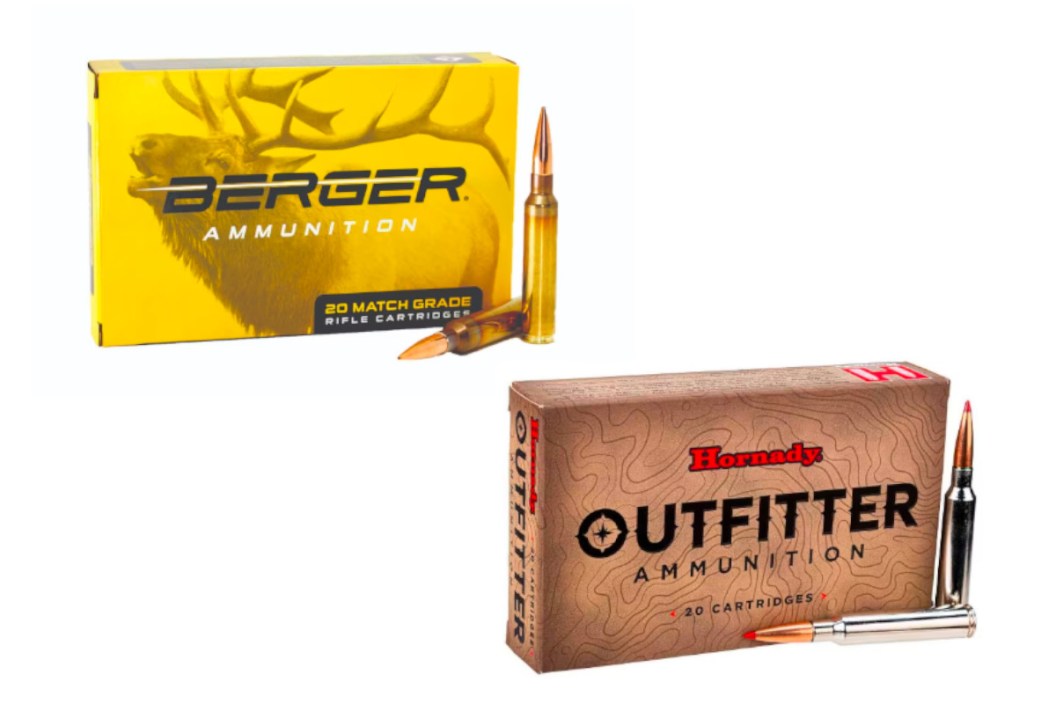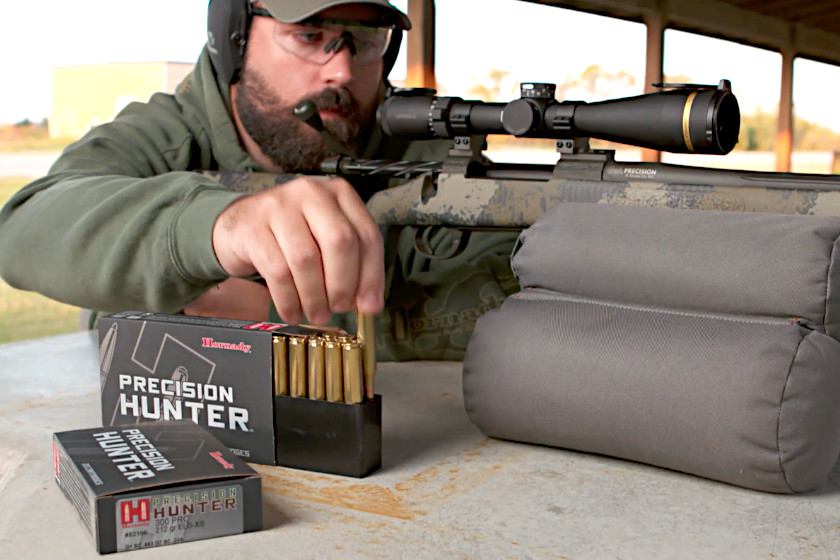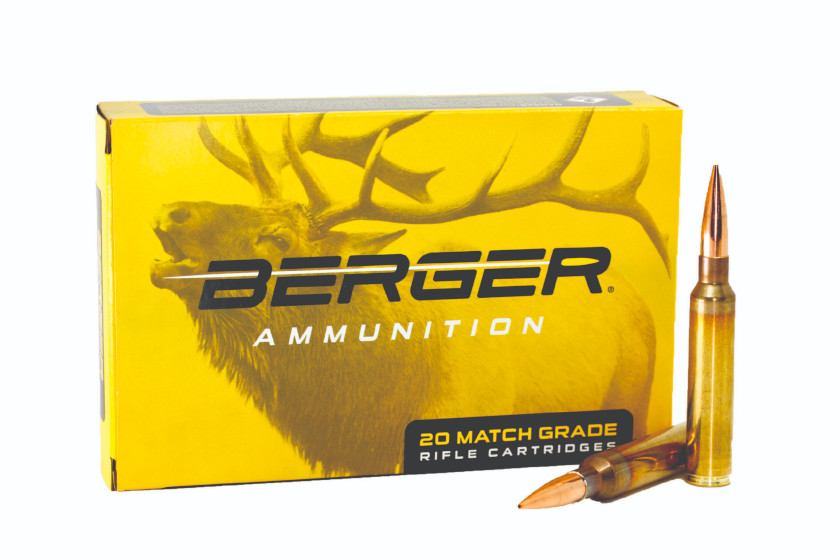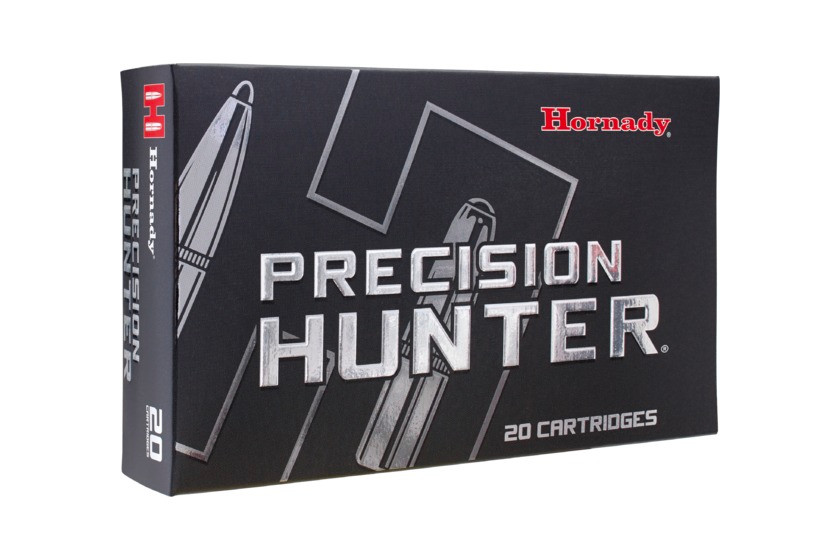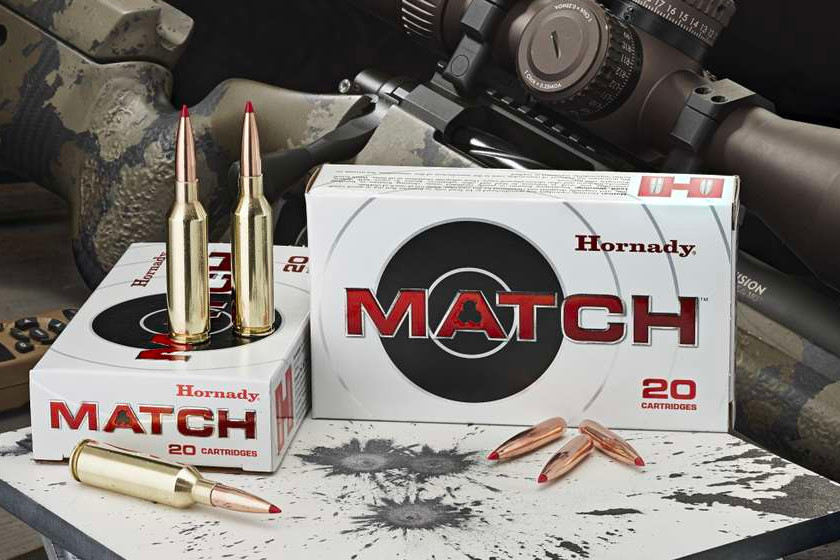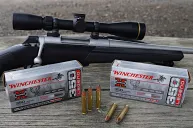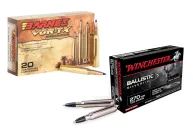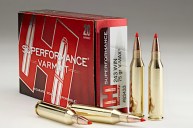More hunters than ever are picking up rifles chambered for the 300 PRC (precision rifle cartridge) these days. It makes total sense. The long-range centerfire round has proved itself both on the competitive shooting range and in the field on North America's largest big game animals time and again since it was first introduced in 2015. We have already talked about the comparisons of this round to another classic Magnum cartridge, the 300 Winchester Magnum. We have also given our recommendations for the top rifles chambered for it.
Today, we are talking exclusively about ammo for this hard-hitting round. We'll answer a few frequently asked questions about the 300 PRC and then touch upon our top picks for factory ammunition you can purchase for competitive target shooting and hunting.
What Is the Effective Range of 300 PRC?
The great thing about the 300 PRC is that while it comes up short against the 300 Win Mag in the speed department, it betters that classic round in energy and accuracy. The 300 PRC was designed with a .532" bolt face and 30-degree shoulder on the non-belted casing that helps carry a great deal of energy downrange to longer distances.
The effective range really depends on your intended use for the 300 PRC. If you're a competitive target shooter, you don't need to be as concerned with energy. In that case, it is not unheard of to push the 300 PRC out to 1,000 or even 1,500 yards. For hunters, a question of ethics comes into the equation. Most 300 PRC rounds are still doing well over 1,500 fps at 1,000 yards and are still retaining enough energy to kill a whitetail or mule deer at that distance. However, we would probably shorten our effective range just to compensate for energy being transferred to the target.
For example, Hornady makes a 212-grain round in its ELD-X Precision Hunter line that carries 2,285 foot-pounds of energy at 500 yards from a 24-inch test barrel. That puts it just over the minimum energy recommend by many state wildlife agencies to kill a moose at that range. While we know hunters have killed elk and other big game beyond that 500-yard mark with this round, we like to err on the side of caution simply because we don't want to chance simply wounding the animal.
Keep in mind that Hornady puts the trajectory at -36 inches at 500 yards for those same rounds. Shooting at a smaller, deer-size target at 500 yards takes a great degree of skill and it is probably not something you want to try unless you have a lot of time and experience dialing in shots like that at the range first. Most average hunters are probably going to be better suited in the 200-to-300-yard range. At those distances, there's less drop and more energy being transferred to the target.
Is 300 PRC Overkill for Deer?
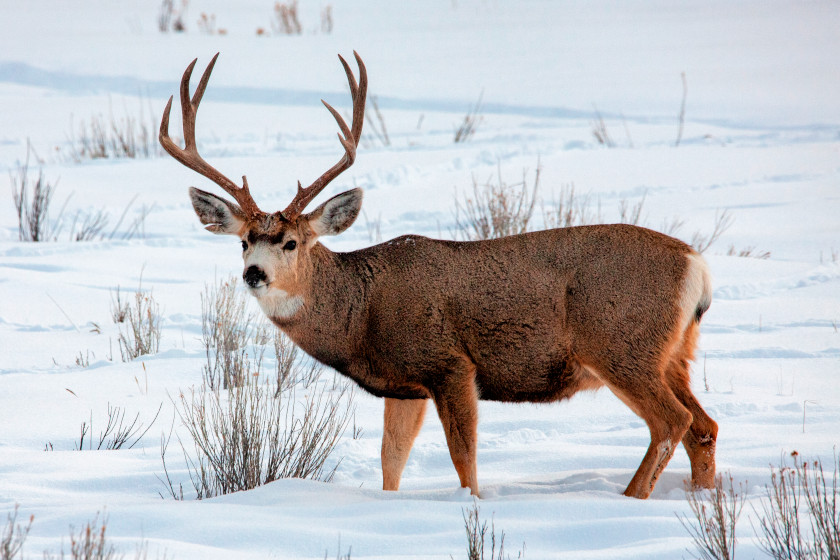
DeniseBush via Getty Images
Speaking of deer, we have heard some concerns from hunters that the 300 PRC is overkill for them, which we understand. This round was purposely designed to accommodate heavier bullet weights in the 190-220-grain range. At normal deer hunting ranges between 50 and 150 yards, it is not uncommon for these bullets to carry upward of 3,500 foot-pounds of energy. This is when concerns about meat damage start coming into play. If you start reading stories of hunters who have harvested deer with a 300 PRC, you will eventually run into stories about some loss, especially with animals that have been shot through the shoulders. It depends on the types of bullets you are using, but the 300 PRC is capable of some devastating wound channels that create some rather large exit holes. There is not really any way around it.
However, an argument can easily be made that it is better to have too much power rather than not enough. Most whitetails and mule deer that are hit with the 300 PRC are going to go down instantly with a single shot just from the shock of that much energy. It is arguable that that is much more humane than using a smaller-caliber just to prevent meat loss. In the end, it is up to each individual hunter as to what they find acceptable in terms to damage to the animal.
Another way to think about it is that the 300 PRC is the more versatile option if you are looking for a one-size-fits-all projectile for North American big game. If you regularly hunt a state such as Wyoming or Montana—where there is the potential for whitetails, mule deer, and elk all in the same hunt—it is nice knowing you can knock down all three with the same gun if necessary. On the other hand, it may not make as much sense to invest in a 300 PRC if you hunt a state such as Georgia or Missouri that is strictly whitetails only, simply because you are hoping to hunt elk, moose, or bear someday.
In a scenario like that, you might be better off spending your money on a dedicated deer caliber that's easier to find in stock, such as the .243, .270, or even the 6.5 Creedmoor. For those who are still set on the 300 PRC as their rifle of choice, we now go to our ammo recommendations.
1. The Best Lead-Free Option
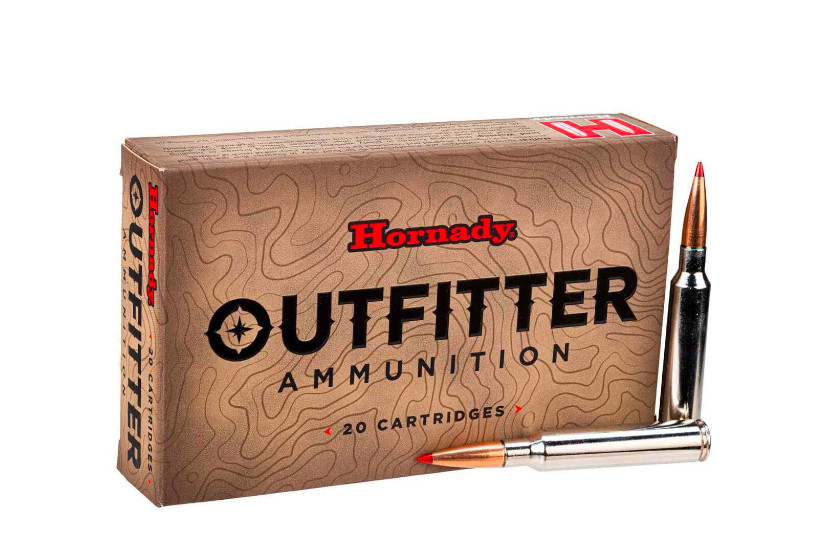
Sportsman's Warehouse
Hornady 300 PRC 190-grain CX Outfitter
Pros:
- A lead-free option for public land.
- 3,000 fps at the muzzle.
- Excellent trajectory.
Cons:
- Price.
- Arguably lacking energy for moose at 500 yards.
If you've just drawn that once-in-a-lifetime tag for a coveted public hunting area, you will not want to skimp on rifle ammunition. These 190-grain rounds feature Hornady's monolithic copper alloy bullet, the CX. It has a ballistic that's going to help it expand nicely upon impact. Hornady loads these in nickel-plated cases with a sealed primer that allows them to stand up to the elements of a rainy or snowy hunt a little better than brass. Because this round has a bullet weight on the low end for a 300 PRC, it's a little faster at 3,000 fps at the muzzle from a 24-inch barrel. At 300 yards, it is still doing 2,521 fps. At 500 yards, it's doing 2,229 fps and hitting with 2,095 foot-pounds of energy. That puts it just below what some states recommend as a safe minimum energy for moose. That is not to say it won't kill a moose at that distance but just that some caution is warranted. We like this round for public land hunts for deer, elk, moose, and bear within the 400-yard range. The downside is that it goes for around $60 a box, so this isn't something you'll want to waste just plinking away at the range with your buddies.
2. The Best Heavy Bullet Option
Berger Elite Hunter
Pros:
- Two options of bullet weight.
- Carries moose-killing energy out to 400 yards.
Cons:
- Price.
Anyone in the reloading world already knows Berger makes some fine hunting bullets. The Elite Hunter Hybrid is a prime example. These boat-tail bullets offer an excellent ballistic coefficient and a hybrid ogive that will help these rounds cut through the higher winds of Western states quite nicely. However, where these rounds really shine is their ability to carry energy downrange. That is why we like them most for elk, bear, and moose hunters. Berger manufactures two variants: a 205-grain and a huge, 245-grain. The 205-grain is doing 2,985 fps at the muzzle and delivers a whopping 4,057 foot-pounds of muzzle energy. The 245-grain version, as expected, is slower at 2,720 fps. However, it is hitting with 4,025 foot-pounds of muzzle energy. This thing is likely going to drop most elk and bears where they stand in the 50-to-200-yard range. The downside to these rounds is the price, which is not unlike other 300 PRC factory ammo options. We saw these rounds going for about $75 a box online, or nearly $3.50 a round. Not cheap. But if you want to use a heavier bullet, these are one of the best options.
3. The Best Option for Within 400 Yards
Hornady 212-grain ELD-X Precision Hunter
Pros:
- Boat-tail design.
- InterLock ring to keep core and jacket together.
Cons:
- Not quite as fast as some other options.
This Hornady Precision Hunter rifle ammo was some of the first released for the 300 PRC, and it continues to perform extremely well for big game. This is our top pick for taking big game at 400 yards. That's mainly because these rounds are doing 2,203 fps at 500 yards and are hitting with 2,285 foot-pounds of energy. That should stop any North American big game animal where it stands. These rounds are not quite as fast as some of the other options on this list, but they do feature a rather efficient boat-tail design with a heat shield tip to help guard against bullet deformation. The InterLock ring of the design helps keep the core and jacket together for some excellent wound channels. Hit an elk or a moose in the vital areas with one of these, and he isn't going very far. They are also usually readily available and affordable at around $60 a box.
4. The Best Long-Range Lead Core Hunting Option
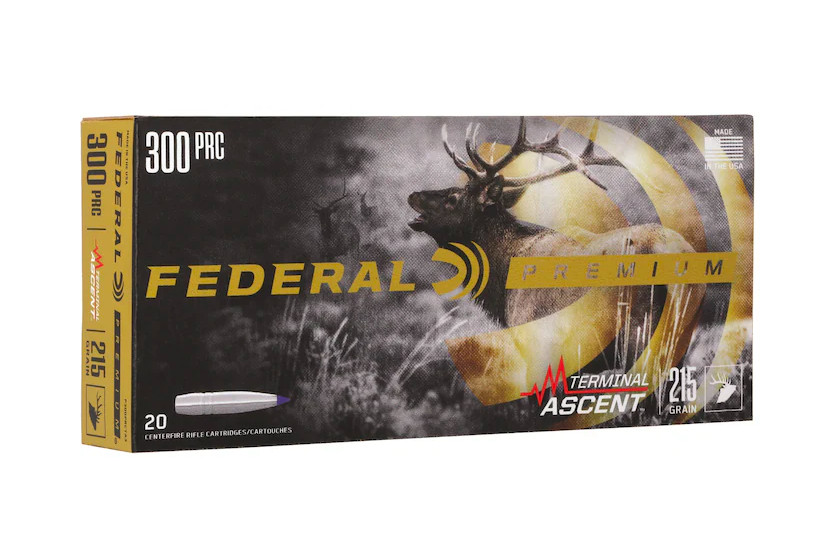
Academy Sports
Federal Premium Terminal Ascent
Pros:
- Low drag.
- Carries energy efficiently.
Cons:
- Extremely hard to find.
Federal Premium designed these rounds specifically for long-range hunting, and these are a solid option for all types of North American big game. These 215-grain rounds feature a boat-tail design. They are nickel-plated bullets with channels designed to minimize drag at greater ranges. Federal Premium gave these bullets a polymer tip with a hollow core design that helps with expansion at ranges out to 500 yards and beyond. They put the muzzle velocity at 2,800 fps and the muzzle energy at 3,900 foot-pounds. These rounds will shoot extremely flat and will drop just about anything on four legs. The only real downside to these is that they are extremely hard to find—even online. The time to buy them is time you see them in stock.
5. The Best Competitive Round
Hornady 300 PRC 225-grain ELD Match
Pros:
- Excellent trajectory and velocity.
- Specifically designed for target shooting.
- Availability.
Cons:
- Not the best for hunting.
If you plan to do some long-range competitive shooting, this is the option to consider. Hornady pairs these rounds with its Match boat-tail design bullets. They feature a lead core plus a secant ogive for flatter trajectory, and they are subject to stricter quality control than Hornady's other offerings. Hornady puts the zero for these rounds at 200 yards, and they only drop -6.9 inches at 300 and -19.5 at 400. Hornady puts the 500-yard drop at -38.4 inches from a 24-inch barrel. The biggest advantage to these rounds is that they are often the only 300 PRC rounds you'll find at many major retailers. At $60 a box, they are rather affordable in comparison to some of the other options. The downside is they are not really built for hunting, so you might have to do quite a bit of searching to find some of the other options on this list if you're prepping for that hunt of a lifetime.
For more outdoor content from Travis Smola, be sure to follow him on Twitter and Instagram. For original videos, check out his Geocaching and Outdoors with Travis YouTube channels.
